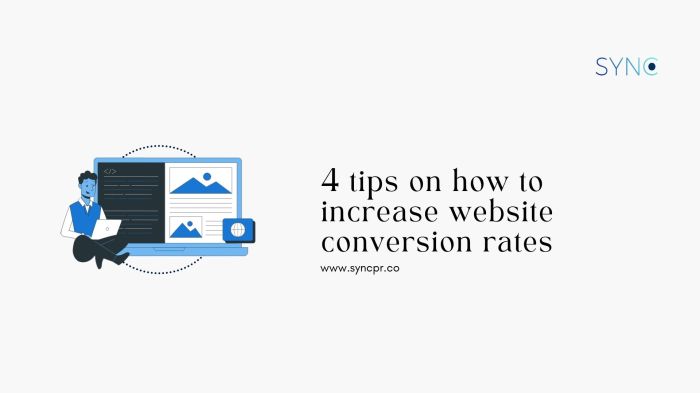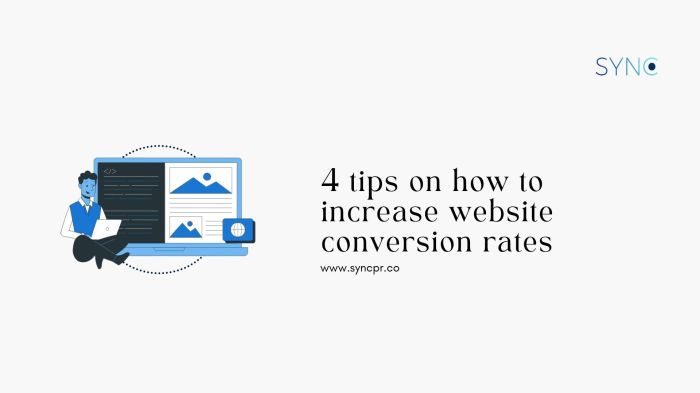Boosting on site conversion performance – Boosting on-site conversion performance is crucial for any online business. This involves understanding what drives conversions, identifying obstacles, and implementing strategies to optimize the user experience. We’ll delve into defining conversion rates, pinpointing conversion bottlenecks, and optimizing for higher conversion rates.
From analyzing user behavior to implementing A/B testing, we’ll explore effective methods for boosting your website’s conversion rate. This comprehensive guide covers everything from understanding key metrics to implementing personalized content strategies.
Understanding Conversion Performance

Conversion rates are the cornerstone of any successful online business. They represent the percentage of website visitors who complete a desired action, such as making a purchase, signing up for a newsletter, or downloading a resource. Understanding and optimizing these rates is crucial for driving revenue and achieving business objectives. This section delves into the factors that impact conversion rates and the importance of careful tracking.Conversion rates are not static; they are dynamic and influenced by a variety of factors.
A deep understanding of these factors is key to identifying areas for improvement and ultimately increasing conversions.
Conversion Rate Definition
Conversion rates are a critical metric for assessing the effectiveness of a website or marketing campaign. A high conversion rate indicates that a significant portion of visitors are taking the desired action, while a low rate signals potential areas for optimization. The calculation is straightforward: the number of conversions divided by the total number of visitors, expressed as a percentage.
Factors Influencing Conversion Rates
Numerous factors influence a website’s conversion rate. Website design, content quality, ease of navigation, and the overall user experience are paramount. Technical issues, such as slow loading times or broken links, can significantly reduce conversion rates. Marketing strategies and promotional offers also play a crucial role.
Types of Conversions
Different types of conversions are relevant to various online businesses. Examples include:
- Purchases: Completing a transaction, a fundamental conversion for e-commerce sites.
- Sign-ups: Collecting email addresses, phone numbers, or other contact information for marketing purposes. This is crucial for building an audience and nurturing leads.
- Leads: Capturing contact information through forms or other methods to generate potential customers for sales.
- Downloads: Encouraging users to download resources like ebooks, white papers, or software trials, a common tactic for lead generation and brand building.
- Content Engagement: Actions such as viewing specific pages, completing quizzes, or participating in polls demonstrate user interest and help to tailor content strategies.
These conversions, individually or collectively, can be optimized to improve revenue and user engagement.
Tracking and Measuring Conversion Rates
Tracking and measuring conversion rates is essential for evaluating the effectiveness of strategies and identifying areas for improvement. By monitoring these rates, businesses can understand what works and what doesn’t, leading to data-driven decision-making. This data allows for adjustments to content, design, and marketing efforts.
Key Metrics for Evaluating Conversion Performance
Understanding key metrics is vital for accurately evaluating conversion performance. A comprehensive approach to measuring success includes various metrics:
| Metric | Description | Target |
|---|---|---|
| Conversion Rate | Percentage of visitors who complete a desired action. | High |
| Bounce Rate | Percentage of visitors who leave the site after viewing only one page. | Low |
| Average Session Duration | Average time visitors spend on the site. | High |
| Pages Per Session | Average number of pages visited per session. | High |
High conversion rates, combined with low bounce rates and longer session durations, generally indicate a positive user experience and effective conversion strategies.
Identifying Conversion Bottlenecks
Unveiling the reasons behind abandoned shopping carts and lost customers is crucial for optimizing your website’s conversion performance. Understanding where visitors drop off in the buying journey allows you to pinpoint the pain points and implement targeted solutions. This in-depth look at conversion bottlenecks will guide you through common issues, from user experience problems to technical glitches, empowering you to improve your conversion rates.Identifying the specific reasons why potential customers abandon their purchase journey is paramount to successful e-commerce.
By analyzing the points of friction in the user experience, you can pinpoint the areas that need improvement and implement targeted solutions. This approach allows you to focus your optimization efforts on the most critical aspects of your website, leading to higher conversion rates.
Common Reasons for Cart Abandonment
A substantial number of potential customers abandon their shopping carts during the checkout process, a common issue that often stems from friction in the purchasing journey. Factors like complex checkout procedures, unclear shipping costs, and insufficient security measures contribute to this problem. Implementing a streamlined checkout process with clear information and secure payment gateways is vital to reducing cart abandonment rates.
User Experience Issues
Poor user experience (UX) can significantly hinder conversions. This can manifest in several ways, including confusing navigation, unclear product descriptions, and a lack of trust signals. A seamless and intuitive user journey is critical to encouraging visitors to complete their purchases.
- Confusing Navigation: A website with unclear navigation structures and poorly designed menus can disorient visitors, making it difficult to find the products they’re looking for. This leads to frustration and ultimately, abandoning the purchase process.
- Unclear Product Descriptions: Insufficient or poorly written product descriptions can leave potential customers with unanswered questions, making them hesitant to proceed with the purchase. Detailed, engaging, and informative product descriptions are crucial for building trust and encouraging conversions.
- Lack of Trust Signals: Customers need reassurance that their information is secure and that the website is legitimate. Absence of trust signals, such as security badges, customer testimonials, or a clear return policy, can create uncertainty and discourage purchases.
Technical Problems
Technical glitches can also lead to significant drops in conversion rates. Issues such as slow loading times, broken links, or compatibility problems across different devices can create a negative user experience and drive visitors away.
- Slow Loading Times: A slow-loading website can significantly increase bounce rates and decrease conversions. Visitors are less likely to wait for a website to load, and they are more likely to abandon the purchase process if the loading time is excessive.
- Broken Links: Broken links lead to frustrating user experiences, making it difficult for visitors to navigate the website. Broken links should be identified and fixed immediately to ensure a smooth user experience.
- Compatibility Issues: Website functionality that isn’t compatible across various devices (desktops, tablets, smartphones) can result in a poor user experience. Ensuring your website is responsive and functions seamlessly across all devices is essential.
Leveraging Analytics Tools
Utilizing analytics tools like Google Analytics is essential for pinpointing conversion bottlenecks. By tracking user behavior throughout the purchase journey, you can identify specific pages or steps where users are dropping off. This data-driven approach allows you to address the issues affecting your conversion rate.
- Identifying Drop-Off Points: Analytics tools can pinpoint the exact pages or steps in the purchase process where visitors are most likely to abandon their carts. This detailed data allows you to focus your optimization efforts on the areas with the most significant impact.
- Analyzing User Behavior: Analytics data can provide insights into the actions visitors take on your website, helping you understand their preferences and needs. This allows for a more targeted and effective approach to improving your website.
Common User Flow Problems
Understanding where users are encountering difficulties in the purchase process is crucial for improving conversion rates. The table below illustrates common user flow problems and potential solutions.
| Problem Area | Description | Potential Solutions |
|---|---|---|
| Checkout Process | Complex steps, unclear shipping costs, insufficient security measures | Simplify checkout, provide clear shipping cost breakdowns, implement strong security measures |
| Product Pages | Poor product descriptions, missing information, lack of high-quality images | Enhance product descriptions, provide detailed specifications, use high-quality images |
| Website Navigation | Difficult to find information, confusing layout, slow loading times | Improve site navigation, use a clear and intuitive design, optimize website performance |
Optimizing for Enhanced Conversions
Turning website visitors into paying customers is the ultimate goal of any online business. Understanding the factors hindering conversions is just the first step. The next crucial phase involves strategic optimization to transform potential customers into actual buyers. This process involves refining website design, layout, and user experience to make the entire journey as seamless and attractive as possible.Effective optimization isn’t a one-time fix; it’s an ongoing process of analysis, testing, and refinement.
By focusing on user needs, pain points, and desires, businesses can cultivate a more engaging and conversion-friendly website experience. This ultimately leads to improved return on investment (ROI) and sustainable growth.
Boosting on-site conversion performance is crucial for any business. Understanding how search engine optimization (SEO) strategies like Ask Maps impact your online presence is key. For example, learning what Ask Maps means for marketers, as discussed in this insightful article ask maps what it means for marketers , can help you tailor your website to attract more customers and ultimately drive sales.
By applying these insights, you can significantly improve your conversion rates.
Design Strategies for Improving Website Usability
Website usability is paramount for driving conversions. A user-friendly site ensures visitors can easily navigate, find what they need, and complete desired actions without frustration. This translates directly into higher conversion rates.Good website design goes beyond aesthetics. It’s about intuitive navigation, clear information architecture, and a seamless user experience. Elements like clear calls to action, well-organized content, and easily accessible contact information are crucial.
Modern users expect websites to be fast, responsive, and mobile-friendly. Failing to address these factors will hinder conversions and damage your brand reputation.
Ways to Improve Website Design and Layout to Boost Conversions, Boosting on site conversion performance
Optimizing the visual layout is essential for a seamless user experience. This includes utilizing whitespace effectively, ensuring clear hierarchy, and implementing a visually appealing color scheme. Consistent branding across all pages strengthens brand recognition and builds trust. Strategic placement of high-impact elements, such as product images and calls to action, can significantly improve conversion rates. The use of high-quality images and videos also plays a crucial role in enhancing the overall aesthetic appeal and conveying product information effectively.
Examples of A/B Testing Techniques to Optimize Conversion Rates
A/B testing is a powerful tool for comparing different versions of website elements to identify which performs better. This iterative process involves presenting two versions of a page element to different groups of users and measuring which performs better. For example, testing different button colors or call-to-action phrases can significantly influence conversion rates. This approach can uncover subtle but impactful changes that lead to improved conversion rates.
The Role of Clear Calls to Action in Encouraging Conversions
Clear and concise calls to action (CTAs) are vital for guiding users toward desired actions. These should be strategically positioned within the website and designed to stand out visually. Examples include “Buy Now,” “Sign Up,” or “Learn More.” A well-crafted CTA encourages users to take the next step, increasing the likelihood of conversion. The clarity and visibility of the CTA directly influence user engagement and subsequent actions.
How to Enhance Mobile-Friendliness for Improved Conversions
Mobile-friendliness is no longer a luxury but a necessity. With a substantial portion of website traffic originating from mobile devices, ensuring a seamless mobile experience is critical for conversions. A responsive website design adapts to various screen sizes, ensuring optimal viewing and navigation on smartphones and tablets. Mobile-friendly design prioritizes ease of use, minimizing friction in the user experience and maximizing engagement.
Best Practices for Designing Effective Calls to Action
| Element | Description | Example |
|---|---|---|
| Button Text | Concise and action-oriented. | “Buy Now,” “Sign Up,” “Learn More” |
| Button Placement | Strategically located to draw attention. | Top of the page, within the product display |
| Button Design | Visually appealing and distinct. | Bold colors, contrasting backgrounds |
Implementing Conversion Rate Optimization Strategies: Boosting On Site Conversion Performance
Conversion Rate Optimization (CRO) is a systematic approach to improving the percentage of website visitors who complete a desired action, such as making a purchase or filling out a form. By focusing on user experience and understanding their motivations, businesses can significantly boost their bottom line. Effective CRO strategies involve a multifaceted approach, encompassing traffic segmentation, personalized content, email nurturing, social media engagement, and compelling content marketing.A crucial aspect of CRO is understanding that not all website visitors are the same.
Targeting specific segments with tailored experiences leads to more effective conversions. By analyzing user behavior, identifying key pain points, and personalizing the experience, businesses can significantly improve conversion rates.
Improving your website’s conversion rates is crucial for any online business. One key aspect is optimizing your site’s structure and content for a seamless user experience. To really supercharge your SEO efforts, exploring resources like boost your seo incredible link building resources can significantly boost your site’s visibility and, in turn, drive more conversions. Ultimately, strong SEO practices are a critical component of any successful strategy to enhance on-site conversion performance.
Segmenting Website Traffic for Targeted Optimization
Understanding your website visitors’ demographics, interests, and behaviors is fundamental to effective segmentation. This data allows you to tailor your website experience to specific groups. For example, a clothing retailer might segment visitors based on their browsing history (e.g., women’s fashion, men’s sportswear) and then display relevant product recommendations. This personalized approach leads to increased engagement and higher conversion rates.
Boosting your website’s conversion rates can be tricky, and often overlooked factors are at play. One crucial area to examine is common JavaScript rendering issues. These problems can significantly hinder a smooth user experience, impacting page load times and ultimately affecting conversion rates. Understanding these issues, like those detailed in this helpful guide on common javascript rendering issues , is key to optimizing your site for better conversion performance.
By fixing these issues, you’ll see a positive impact on your overall conversion rate.
Analyzing traffic data, such as location, device used, and previous interactions with the website, is crucial to creating targeted segments.
Examples of Personalized Content to Improve Conversion Rates
Personalized content is key to a successful CRO strategy. This involves tailoring website content, product recommendations, and offers based on individual user preferences and behaviors. For example, if a visitor browses products for running shoes, personalized recommendations for matching apparel and accessories can significantly increase the likelihood of a purchase. By using data-driven insights, businesses can create highly targeted landing pages that resonate with specific customer segments.
The use of dynamic content is critical in this regard.
Using Email Marketing to Nurture Leads and Boost Conversions
Email marketing plays a pivotal role in nurturing leads and driving conversions. Segmentation is crucial in email campaigns. Tailoring email content based on customer behavior and preferences can significantly improve open and click-through rates. Abandoned cart emails, for example, are highly effective in reminding customers of items left in their cart and prompting a purchase. Businesses should also leverage email marketing to send targeted promotions and exclusive offers to specific customer segments.
Regularly analyzing email campaign performance metrics is vital to refine strategies and optimize results.
Using Social Media for Driving Traffic and Conversions
Social media platforms can be powerful tools for driving traffic and conversions. By creating engaging content and running targeted advertising campaigns, businesses can reach a wider audience and generate leads. Social media advertising platforms provide sophisticated targeting options allowing businesses to reach specific demographics, interests, and behaviors. For instance, a cosmetics company could target users interested in makeup tutorials and beauty trends on Instagram.
The Role of Content Marketing in Improving Conversion Rates
High-quality content marketing is essential for building brand authority, attracting potential customers, and driving conversions. By creating valuable content, such as blog posts, articles, and videos, businesses can position themselves as thought leaders in their industry. This content can educate potential customers about their products or services, address their needs, and build trust. This approach helps generate organic traffic and convert visitors into loyal customers.
Content marketing should focus on delivering value to the target audience.
Actionable Steps to Implement Conversion Rate Optimization
A structured approach is vital for implementing CRO strategies. Here’s a list of actionable steps:
- Implement A/B testing on different versions of your website pages. A/B testing involves comparing two versions of a webpage to determine which performs better in terms of conversions. For example, testing different call-to-action buttons or layout designs can help optimize user experience.
- Analyze the results of your A/B tests to identify areas for improvement. Thorough analysis of A/B test results is crucial to understanding which design elements resonate best with users. Identifying patterns in conversion rates based on different variations helps pinpoint areas needing improvement.
- Update your website pages based on the results of your A/B tests. Implementing changes based on A/B test results is crucial. This iterative process continuously refines website design and user experience to maximize conversions. Continuously monitoring and optimizing the website based on test results is key.
Continuous Monitoring and Analysis

Conversion rate optimization isn’t a one-time project; it’s an ongoing process. Continuous monitoring and analysis are crucial for maintaining high conversion rates and adapting to evolving user behavior. Understanding how your website performs over time, and identifying patterns and trends, is key to ensuring your efforts yield the best possible results.Staying ahead of the curve requires constant evaluation of your strategies.
Regular checks allow you to adjust your approach in response to changes in user behavior, market trends, and even seasonal shifts.
Importance of Continuous Monitoring
Regular monitoring of conversion rates provides critical insights into the effectiveness of your optimization efforts. By tracking key metrics, you can identify areas needing improvement and measure the impact of changes you’ve implemented. This ongoing evaluation ensures your website remains competitive and resonates with your target audience. For instance, if a specific promotion or landing page experiences a significant drop in conversions, you can quickly investigate the cause and implement corrective measures before the issue escalates.
Utilizing Analytics Tools
Comprehensive analytics tools are essential for monitoring conversion performance. Tools like Google Analytics provide detailed insights into user behavior, including the pages users visit, how long they stay, and the actions they take. Analyzing this data allows you to pinpoint specific areas that require attention, from improving website navigation to optimizing product descriptions. For example, if you notice a high bounce rate on a particular product page, you can investigate the reasons and potentially redesign the page to improve user engagement and conversions.
Actionable Steps for Identifying Issues
Regularly review your key performance indicators (KPIs) to pinpoint potential issues. A drop in conversion rates, high bounce rates on specific pages, or changes in user behavior patterns can all indicate problems needing attention.
- Analyze landing page performance: Evaluate which landing pages are performing well and which are not. Look for patterns in user behavior on underperforming pages. For example, are users leaving at a specific point in the checkout process? Are the calls to action unclear or ineffective? This analysis can reveal bottlenecks in the conversion funnel.
- Track user journey: Examine the entire user journey from initial interaction to conversion. Are users encountering friction points along the way? This includes evaluating factors like website navigation, page load times, and the clarity of calls to action.
- Monitor seasonal trends: Seasonal variations in user behavior can impact conversion rates. Be mindful of how your site performs during different times of the year. Understanding seasonal patterns can inform proactive adjustments to your strategy and help prevent unexpected dips in conversions.
Methods for Optimizing Conversion Rates
Based on the insights gathered from monitoring and analysis, implement targeted optimizations.
- A/B testing: Experiment with different versions of elements on your website, such as headlines, images, and calls to action. This iterative process allows you to identify which variations perform better and improve user experience.
- User testing: Gather feedback from real users to understand their experience and identify potential areas of improvement. This can be through user interviews, surveys, or usability testing sessions.
- Content optimization: Enhance the quality and relevance of your website content. Ensure it is engaging, informative, and meets the needs of your target audience.
Adapting to Changes in User Behavior
User behavior is constantly evolving, requiring ongoing adaptation of your strategies. Stay informed about current trends and emerging technologies.
- Stay informed about industry trends: Keep abreast of emerging trends in your industry and how they impact user behavior. This includes keeping an eye on new technologies and tools.
- Regularly analyze user data: Continuously monitor and analyze user data to identify shifts in preferences and behaviors. For instance, if a specific feature becomes popular among users, consider integrating it into your strategy.
Epilogue
In conclusion, achieving high conversion rates requires a multifaceted approach that combines data analysis, user-centered design, and continuous optimization. By meticulously tracking key metrics, identifying bottlenecks, and implementing targeted strategies, you can significantly boost your website’s conversion performance. Remember, continuous monitoring and adaptation to evolving user behavior are essential for long-term success.






